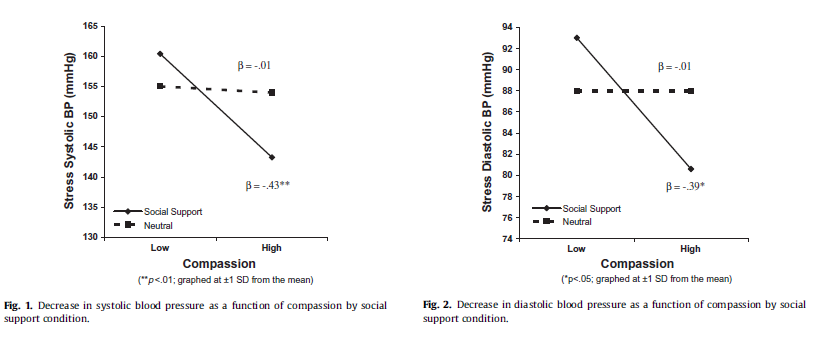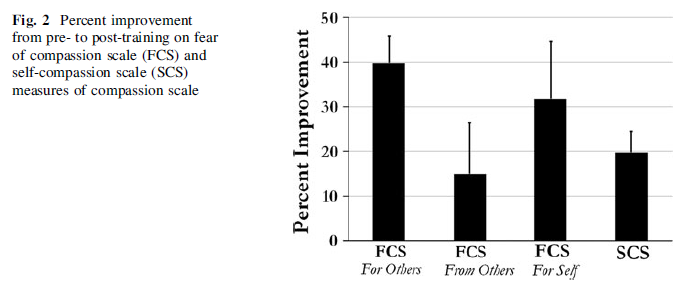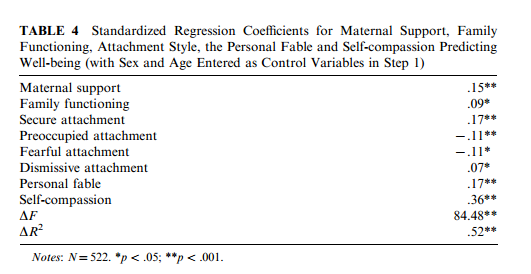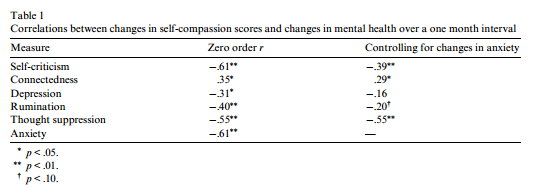There might be affiliate links on this page, which means we get a small commission of anything you buy. As an Amazon Associate we earn from qualifying purchases. Please do your own research before making any online purchase.
The Science of Compassion
See the studies behind compassion. Why does compassion help? What can it do? Why does it matter? Discover the science of compassion and how it can make a difference in your life.
Many studies are beginning to show not only the positive impact of having more compassion but the effectiveness of techniques to improve it.
However, many methodological concerns remain: sample sizes are usually small (50 to 100); control groups are usually wait-lists (which are not placebo controlled); studies are short-term, usually two to three months; the effect sizes are sometimes small (<10%) and the control groups have a disproportionate tendency to also show increases in compassion (rather than a normal distribution centered around delta 0), suggesting a partial exposure effect.
Table of Contents
- Correlational
- Self-Compassion is a Better Predictor Than Mindfulness of Symptom Severity and Quality of Life in Mixed Anxiety and Depression
- Is Compassion For Others Stress Buffering? Consequences of Compassion and Social Support For Physiological Reactivity to Stress
- The Role of Self-compassion in Romantic Relationships
- Self-Compassion and Psychological Resilience Among Adolescents and Young Adults
- Experimental
- Open Hearts Build Lives: Positive Emotions, Induced Through Loving-Kindness Meditation, Build Consequential Personal Resources
- Effect of Compassion Meditation on Neuroendocrine, Innate Immune and Behavioral Responses to Psychosocial Stress
- Enhancing Compassion: A Randomized Controlled Trial of a Compassion Cultivation Training Program
- Self-Compassion and Adaptive Psychological Functioning
- Miscellaneous
- Effects of Taiji Practice on Mindfulness and Self-Compassion in Healthy Participants—A Randomized Controlled Trial
- Loving-Kindness Meditation to Enhance Recovery From Negative Symptoms of Schizophrenia
- A Pilot Study of Loving-Kindness Meditation For The Negative Symptoms of Schizophrenia
- Loving-Kindness and Compassion Meditation: Potential for Psychological Interventions
Open Hearts Build Lives: Positive Emotions, Induced Through Loving-Kindness Meditation, Build Consequential Personal Resources
Study explored the impact of loving-kindness meditation on positive emotion and a wide range of well-being measures.
Protocol
6, hour long group sessions held over 7 weeks, 20-30 people per group. Average time spent meditating was 60 minutes a week (the weekly group session was 40 minutes of lecture and 20 minutes of meditation). Sample size of 200 (102 meditation; 100 control).
Variables
Time spent meditating compared against:
-Positive emotion: a weekly, composite variable which averaged daily experiences of amusement, awe, contentment, joy, gratitude, hope, interest, love, and pride (o to 4 for each emotion). Used Kahneman's day reconstruction method.
-Cognitive resources (mindfulness and awareness), agency thinking, savoring, optimism, ego-resilience, psychological well-being, adjustment, positive relations with others, illness, sleep duration, satisfaction with life, and depression.
Results
-Over the course of the 9 weeks, measures of positive emotion increased by about 10%.
-As participants became more skilled in the practice, each hour of meditation exerted greater effect on positive emotion felt (week 1, 1 hour of meditation increased positive emotion by about 2.5%; week 7, 1 hour of meditation increased positive emotion by about 7%).
-Participants did not have to meditate every day to feel better every day; that is, the effect on positive emotion was not simply how much time the subject meditating that day, but how much they meditated over the past few weeks. However, participants did feel better on those days they meditated.
-Positive emotion significantly improved 9 of the 18 general well-being measures: mindfulness, pathways thinking, savoring, environmental mastery, self-acceptance, purpose in life, social support received, positive relations with others, and illness symptoms. These in turn acted on life satisfaction.
-Positive emotion was not directly correlated with increased life satisfaction – that is, positive emotion improved life satisfaction only so much as it built personal resources (such as the nine mentioned above). I believe this result deserves to be more fully explored and tested.
Concerns
-Control group used was not sham meditation, but a do-nothing wait-list. As a result, the effects of LKM could be because of the basic act of meditation, and not the specific meditation that LKM represents. Results could also be because of placebo effect. Rational offered by authors for not using a representative control is questionable (‘we don't want to waste the time of our subjects').
-Study was short – 7 weeks of LKM, and 9 weeks of practice. It's possible the effects could degrade over time, although the trend from the study was the opposite.
-Sample was “predominantly White, educated, and motivated for self-change.”
-One of the primary authors is Barbara Fredrickson. As the originator of the broaden-and-build theory, she holds a bias to confirm research which supports her thesis (like this study).
Full study here.
Journal of Personality and Social Psychology, 2008
Barbara Fredrickson, Kimberly Coffey, Michael Cohn, Sandra Finkel, Jolynn Pek
Fredrickson, B. L., Cohn, M. A., Coffey, K. A., Pek, J., & Finkel, S. M. (2008). Open Hearts Build Lives: Positive Emotions, Induced Through Loving-Kindness Meditation, Build Consequential Personal Resources. Journal Of Personality & Social Psychology, 95(5), 1045-1062.
Self-Compassion is a Better Predictor Than Mindfulness of Symptom Severity and Quality of Life in Mixed Anxiety and Depression
This study compared the life-improving effects of mindfulness against self-compassion. The results suggest LKM to be just as or more effective than mindfulness meditation in improving quality of life.
Protocol
Participants completed a set of questionnaires. Sample size of 504; 90% of participants had one sought psychiatric services; 50% currently taking psychiatric medicine, 46% in therapy; 87% experiencing anxiety or depression; 62% experiencing anxiety and depression.
Variables
Mindfulness (Mindful Attention Awareness Scale) and self-compassion (Self-Compassion Scale) compared against:
-Anxiety (Beck Anxiety Inventory), depression (Beck Depression Inventory), worry (Penn State Worry Questionnaire), and quality of life (Quality of Life Inventory).
Results
Self-compassion was two to three times more predictive than mindfulness in explaining anxiety, depression, worry, and quality of life.
Concerns
The study tested correlation, not causation: the study does not show that self-compassion can be as easily increased as mindfulness, and even if self-compassion can be trained, this study has not shown that this increase would actually increase the quality of life. A longitudinal study comparing the effects of mindfulness meditation against LKM meditation would be significantly more revealing.
Science of Compassion Resources
Journal of Anxiety Disorders, 2010
Nicholas Van Dam, Sean Sheppard, John Forsyth, Mitch Earleywine
Van Dam, N. T., Sheppard, S. C., Forsyth, J. P., & Earleywine, M. (2011). Self-compassion is a better predictor than mindfulness of symptom severity and quality of life in mixed anxiety and depression. Journal Of Anxiety Disorders, 25(1), 123-130. doi:10.1016/j.janxdis.2010.08.011
Is Compassion For Others Stress Buffering? Consequences of Compassion and Social Support For Physiological Reactivity to Stress
Study examines the hypothesis that, “social support is most beneficial for those best able to take advantage of it: individuals high in compassion.”
Protocol
59 San Franciscan women completed questionnaires. They were then hooked up to an EEG and ICG, and blood pressure sensors. Finally, they were instructed to give a speech to two evaluators (a simulation of stress). Half the group had supportive evaluators (smile; you're doing a great job), half had neutral evaluators (flat non-verbal feedback).
Variables
Compassion (the compassion subscale of the dispositional positive emotion scales), defensiveness, cynicism, pessimism, negative affect, self-esteem, self-efficacy, loneliness, perceived support, and social power were compared against three measures of stress: arterial blood pressure, cortisol, and heart rate variability (across the two conditions).
Results
-“Compassion for others was not significantly correlated with any of the baseline physiological measures.” This implies that being more compassionate does not lower your day to day levels of stress.
-There was no relationship between compassion and stress in the neutral condition.
-In the support condition, those with more compassion experienced less stress. This result was true only of compassion, and none of the other nine predictive variables.
Concerns
-All subjects were female, and sample size was small.
-The neutral evaluators seemed more like rejection evaluators to me. This in turn implies that compassion could effect neutral situations as well as supportive ones.
Journal of Experimental Social Psychology, 2010
Brandon Cosley, Shannon McCoy, Laura Saslow, Elissa Epel
Cosley, B. J., McCoy, S. K., Saslow, L. R., & Epel, E. S. (2010). Is compassion for others stress buffering? Consequences of compassion and social support for physiological reactivity to stress. Journal Of Experimental Social Psychology, 46(5), 816-823. doi:10.1016/j.jesp.2010.04.008
Effect of Compassion Meditation on Neuroendocrine, Innate Immune and Behavioral Responses to Psychosocial Stress
Studies measured the immune and stress modulating effects of LKM.
Protocol
For six weeks, 33 participants trained in compassion meditation twice a week (50-min class twice a week, average of 20 min of meditation), and 28 participants in a health discussion ‘control group'. Between weeks 8 through 10, subjects participated in a stress test and completed questionnaires.
Variables
Average number of meditation sessions per week was compared against general distress before and after the stress tests (30-item Profile of Mood States) and against IL-6 and cortisol levels.
Results
-Prior to the stress test, the meditation and control group did not differ.
-After the stress test, the meditation group showed a better immune and stress response than the control group. Specifically, the there was a strong inverse correlation between number of meditation sessions and outcome variables (e.g. -.3 to -.4).
-To address the concern that those with a better stress response are more likely to meditate (rather than those who meditate more having a better stress response), the authors checked for and found no (statistically significant) correlation between initial stress response and inclination to meditate.
Concerns
-Small sample size.
-No real control condition.
Full study here.
Journal of Psychoneuroendocrinology, 2009
Thaddeus Pace, Lobsang Negi, Daniel Adame, Steven Cole, Teresa Sivilli, Timothy Brown, Michael Issa, Charles Raison
Pace, T. W., Negi, L., Adame, D. D., Cole, S. P., Sivilli, T. I., Brown, T. D., & … Raison, C. L. (2009). Effect of compassion meditation on neuroendocrine, innate immune and behavioral responses to psychosocial stress. Psychoneuroendocrinology, 34(1), 87-98. doi:10.1016/j.psyneuen.2008.08.011
Enhancing Compassion: A Randomized Controlled Trial of a Compassion Cultivation Training Program
Study wished to test the effectiveness of compassion cultivation training (CCT) for enhancing levels of compassion.
Protocol
100 participants, 60 assigned to CCT, 40 to wait-list. Notably, participants were adults. “CCT is a structured protocol that consists of a 2-h introductory orientation, eight once weekly 2-h classes, and daily compassion-focused meditation practice.”
“Each class includes: (a) pedagogical instruction with active group discussion, (b) a guided group meditation, (c) interactive practical exercises related to the specific step of the week, and (d) exercises designed to prime feelings of open-heartedness or connection to others, either through reading poetry or through reflecting on inspiring stories. Participants are encouraged and instructed to engage in daily informal and formal home meditation practice for at least 15 min (building up to 30 min) using pre-recorded guided meditations”
Variables
-The Fears of Compassion Scales (FCS; Gilbert et al. 2010) and the Self-Compassion Scale (SCS; Neff 2003a).
-Weekly minutes of CCT meditation.
Results
-Average weekly meditation time was 101 minutes. Meditation time was correlated with less fear of compassion for others, but no other measures.
-Fear of compassion significantly reduced (15 to 40%), and self-compassion significantly increased (20%).
Concerns
-Poor control – is a waitlist rather than an alternative attempt at cultivating compassion (e.g. different form of meditation, prayer, volunteer work, CFT, etc…).
-Unknown if benefits persist past training period.
Full study here.
Journal of Happiness Studies, 2012
Hooria Jazaieri, Geshe Jinpa, Kelly McGonigal, Erika L. Rosenberg, Joel Finkelstein, Emiliana Simon-Thomas, Margaret Cullen, James Doty, James Gross, Philippe Goldin
Hooria Jazaieri, Geshe Jinpa, Kelly McGonigal, Erika L. Rosenberg, Joel Finkelstein, Emiliana Simon-Thomas, Margaret Cullen, James Doty, James Gross, Philippe Goldin (2012). Enhancing compassion: A randomized controlled trial of a compassion cultivation training program. Journal of Happiness Studies, doi:10.1007/s10902-012-9373-z
The Role of Self-compassion in Romantic Relationships
This study compared the role of self-compassion in predicting relationship success against self-esteem.
Protocol
104 heterosexual couples filled out a series of surveys. “Relationship length ranged from 1 to 18 years (Mlength 3.8 years), with 39% of couples married, 41% co-habiting, and 21% living separately. Sixty percent of participants had children. The age of participants ranged from 18–44 years old (Mage 26.9 years)”
Variables
Self-Compassion Scale (SCS; Neff, 2003a), perception of partner’s self-compassion (variation of SCS), and Rosenberg Self-Esteem Scale (RSE; Rosenberg, 1965) against:
-Relational well-being (Harter, Waters, & Whitesell, 1998; Neff & Harter, 2003), Intimate Bond Measure (IBM; Wilhelm & Parker, 1988), Autonomy and Relatedness Inventory (ARI; Hall & Kiernan, 1992; Schaefer & Edgerton, 1982), Conflict Tactics Scale (Straus & Gelles, 1990), Relationship Assessment Scale (RAS; Hendrick, Dicke, & Hendrick, 1998), and the Relationship Questionnaire (RQ; Bartholomew & Horowitz, 1991).
Results
-Women reported 8% less SC than men, “a finding which is consistent with prior research (e.g., Neff, 2003a; Neff & Vonk, 2009).”
-“The link [for SC] was significantly positive for Care, Relatedness, Acceptance, and Autonomy, supporting the hypothesis that higher levels of SC would be associated with more positive perceptions of one’s own behaviors and attitudes by relationship partners. The link [for SC] was significantly negative for Control, Detachment, Dominance and Verbal aggression, supporting the hypothesis that higher levels of SC would be associated with less negative perceptions of the one’s own behaviors and attitudes.”
-Self-Compassion was more predictive of relationship success than Self-Esteem (SE) – the table below canceled out the shared variance between SC and SE. Notably, SC was correlated with extremely less dominance and verbal aggression. On the other hand, self-esteem was correlated with increased dominance and verbal aggression, leading to the possibility that self-compassion is a safer, more effective version of self-esteem.
Concerns
This is a correlational study – “While it may be the case the higher preexisting levels of SC enhance relationship functioning, it may be that harmonious and close relationships enhance the ability to be self-compassionate.”
Full study here.
Journal of Self and Identity, 2012
Kristin Neff, S. Natasha Beretvas
Neff, K. D., Beretvas, S. N. (2012). The role of self-compassion in romantic relationships. Self and Identity. DOI:10.1080/15298868.2011.639548
Self-Compassion and Psychological Resilience Among Adolescents and Young Adults
This study examined the effect of self-compassion on the well being of adolescents, as near all previous research had focused on college students or adults. In addition, the study examined self-compassion as an alternative to self-esteem, “the need for high self-esteem has been found to contribute to certain problematic behaviors, including bullying, aggression, self-enhancement bias, and narcissism.”
Protocol
Sample of 235 adolescents, and 287 college students (the control). Participants completed a series of surveys.
Variables
Self-Compassion Scale (SCS; Neff, 2003a), Beck Depression Inventory (BDI; Beck & Steer, 1987), Spielberger State-Trait Anxiety Inventory–Trait form (Spielberger, Gorsuch, & Lushene, 1970), Social Connectedness Scale (Lee & Robbins, 1995), maternal subscale of the FamilyMessages Measure (Stark, Schmidt, & Joiner, 1996), Index of Family Relations (Hudson,1992), Relationship Questionnaire (Bartholomew & Horowitz, 1991), and the personal uniqueness subscale of the New Personal Fable Scale (Lapsley et al., 1989).
Results
-“Maternal support and family functioning were significant predictors of self-compassion. Attachment style also predicted self-compassion, with secure attachment positively associated with self-compassion, and preoccupied and fearful attachment negatively associated with self-compassion.”
-“Those who displayed the personal fable—the sense that the self’s experiences are unique and not shared by others—reported significantly lower levels of self-compassion. (r= .28 to .33)”
-“Self-compassion was a significant partial mediator between maternal support and well-being.” In english, “one way parents may influence their children’s functioning is by fostering self-compassionate or self-critical inner dialogues.”
-Self-compassion was significantly correlated with well-being (r=.36), even after controlling for several potential underyling factors (e.g. maternal support), as seen in the table below:
Concerns
-There are potentially other confounding variables not considered by this study, in which case self-compassion would not be a distinctly predictive construct.
-Correlational.
-“The participants in the study were largely white and middle class.”
Full study here.
Journal of Self and Identity, 2010
Kristin Neff, Pittman McGehee
Neff, K. D. & McGeehee, P. (2010). Self-compassion and psychological resilience among adolescents and young adults. Self and Identity, 9, 225-240.
Self-Compassion and Adaptive Psychological Functioning
Two studies which examined potential ways in which self-compassion may improve well-being.
Study 1: Examines the effectiveness of self-compassion and self-esteem in buffering against anxiety.
Protocol
91 undergraduates filled out a series of surveys, went through a “mock job interview situation [where they] were asked to give a written answer to the dreaded but inevitable interview question, ‘Please describe your greatest weakness'”, filled out the anxiety measure for the second time, and then finally answered the mock interview questions again.
Variables
Self-Compassion Scale (SCS; Neff, 2003a), Rosenberg self-esteem scale (RSE; Rosenberg, 1965), Positive and Negative AVect Schedule (PANAS; Watson, Clark, & Tellegen, 1988), Speilberger State-Trait Anxiety Inventory—State form (Spielberger, Gorsuch, & Lushene, 1970), and text analysis of their interview answers – a tally of four categories of words ““First person singular” (pronouns such as I and me); “First person plural” (pronouns such as we and our); “Social references” (social words such as friend, talk or share): and “Negative emotions” (words such as nervous, angry or sad).”
Results
-“Self-compassion was associated with significantly less anxiety after considering one’s greatest weakness (r = -.21, p< .05).” In comparison, self-esteem had a correlation of r=-.11.
-“Self-compassion was negatively correlated with use of first person singular pronouns such as “I” (r =-.21, p < .05). Self-compassion was also positively correlated with use of first person plural pronouns such as “we” (r = .23, p < .05) and with social references such friends, family, communication, and other humans (r = .21, p6.05).”
Concerns
-No control.
-Correlational; which is the concern that the second study attempted to address.
Study 2: Moves from correlation into causality – attempting to increase levels of self-compassion, and then seeing if that increases levels of well-being.
Protocol
40 college students (38 females) completed a set of surveys, underwent the “Gestalt two-chair” exercise (Greenberg, 1983, 1992), and were then retested.
“The intervention was created to assist clients in challenging maladaptive, self-critical beliefs, allowing them to become more empathic towards themselves (Safran, 1998). In this approach, two conflicting aspects of the self are given voice—a self-critical voice and an “experiencing” voice that feels criticized, so that each is allowed to express its own values, wants, and needs. The goal of the exercise is to arrive at a point where the part of the self that feels judged and unworthy “comes to know and appreciate itself [so that one] feels compassion for the newly discovered vulnerable self.”
Variables
Therapist ratings of participants’ self-compassion levels and Self Compassion Scale against:
-Self-Criticism subscale of Blatt, D’AZitti, and Quinlan (1976) Depressive Experiences Questionnaire (DEQ), The Social Connectedness Scale (Lee & Robbins, 1995), Speilberger State-Trait Anxiety Inventory—Trait form (Spielberger et al., 1970), Beck Depression Inventory (Beck, Ward, Mendelson, Mock, & Erbaugh, 1961), Ruminative Responses scale (Butler & Nolen-Hoeksema, 1994), and the White Bear Suppression Inventory (Wegner & Zanakos, 1994).
Results
-“Those who experienced an increase in self-compassion also experienced increased social connectedness and decreased self-criticism, depression, rumination, thought suppression, and anxiety.”
Concerns
-Small sample size, and near all female population (95%).
-The study does not actually mention how much self-compassion changed over the course of the study, suggesting the change was small.
Full study here.
Journal of Research in Personality, 2007
Kristin Neff, Kristin Kirkpatrick, Stephanie Rude
Neff, K. D., Kirkpatrick, K. & Rude, S. S. (2007). Self-compassion and its link to adaptive psychological functioning. Journal of Research in Personality, 41, 139-154.
Self-Compassion, Interpersonal Conflict Resolutions, and Well-being
Study examined the effects of self-compassion on conflict resolution.
Protocol
506 college students completed a series of surveys.
Variables
Self-Compassion Scale (SCS; Neff, 2003a) against:
-Conflict resolution behavior: “Participants were asked to provide a written example of a real-life situation in which their needs or desires conflicted with those of their mother, father, best friend, and romantic partner… Participants were asked to report how they resolved the conflict given the following three choices, self-subordination, compromise, or self-prioritization.”
-Authentiticy: “‘When you resolved conflicts this way, did you feel like you were being your true self, the real you, or did it feel false, that you were acting that way, but it was not the real you?'’”
-Emotional Turmoil: The degree of inner conflict and turmoil felt while resolving the conflict (1 to 5).
-Relational Well-Being
Results
-Men were 5% more self-compassionate than women.
-“Males showing a slightly greater tendency to self-subordinate with romantic partners than females (31.9% of resolutions among males, compared to 22.8% of resolutions among females).” Hah! Which gender is selfish now!
-“For each one-point increase in self-compassion, participants were 61% more likely to compromise with mothers, 47% more likely to compromise with fathers, 117% more likely to compromise with best friends, and 100% more likely to compromise with romantic partners, relative to self-subordinating. Participants were also 53% more likely to compromise with romantic partners, relative to self-prioritizing.” For reference, a one-point increase in self-compassion is about a 33% increase.
-“For each one-point increase in self-compassion, odds for participants to resolve conflicts authentically (opposed to inauthentically) increased with mothers by a factor of 3.15 (a 215% increase), with fathers by a factor of 2.25 (a 125% increase), with best friends by a factor of 1.59 (a 59% increase), and with romantic partners by a factor of 1.63 (a 63% increase).”
-“Self-compassion was significantly associated with less emotional turmoil: r =-.32; fathers, r=-.35; best friends, r=-.23; and romantic partners r=-.28.”
-“Self-compassion was significantly associated with greater relational well-being: mothers, r=.23; fathers, r=.29; best friends, r=.22; and romantic partners, r=.17.”
Concerns
-“The tendency for individuals to claim that they compromised in their relationships may have been inflated.”
-Sample was of college students.
-“Self-reports of conflict resolution behavior were retrospective, so it is possible that in looking back at past conflicts, participants judged resolutions more positively.” It's possible more compassionate people are also more optimistic, which in turn makes them more likely to positively color past events.
Full study here.
Journal of Self and Identity, 2012
Lisa Yarnell, Kristin Neff
Yarnell, L. M., Neff, K. D. (2012). Self-compassion, interpersonal conflict resolutions, and well-being. Self and Identity. DOI:10.1080/15298868.2011.649545
Effects of Taiji Practice on Mindfulness and Self-Compassion in Healthy Participants—A Randomized Controlled Trial
Study examines the effects of tai-chi practice on mindfulness and self-compassion. “The Taiji course lasted for 12 weeks. Training sessions took place twice a week and lasted for 60 min each.” Problems include a poor control – a waitlist, and a small sample size (35 tai-chi, 35 control).
The results are not suggestive of tai-chi as an effective method of increasing self-compassion. The tai-chi group increased their levels of compassion by 5 to 10%. While statistically significant, the control also increase their levels of compassion by 2 to 7%.
Full study here.
Loving-Kindness Meditation to Enhance Recovery From Negative Symptoms of Schizophrenia
Study is a case analysis of three patients suffering from schizophrenia, all three of which showed improvement from loving kindness meditation (LKM), and one showing large improvement. Given the myriad biases which plague case analyses, this study can be taken as a sign that LKM may work, and deserves rigorous investigation, not that it actually does.
Full article here.
A Pilot Study of Loving-Kindness Meditation For The Negative Symptoms of Schizophrenia
Better than the above study, which had only 3 participants, this study had 18 participants. LKM improved patient symptoms, but 18 participants is still extremely small, and the lack of a control is concerning.
Full article here.







2 thoughts on “The Science of Compassion”